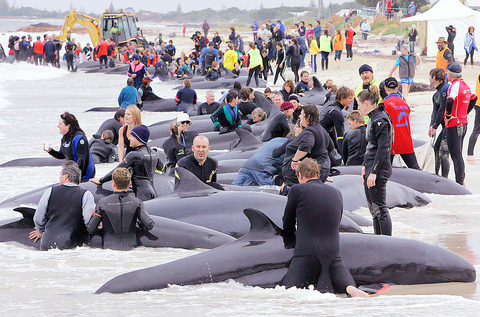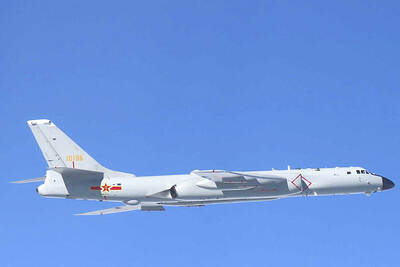Dozens of volunteers in wet suits and wooly hats braved chilly seas yesterday to push scores of false killer whales that had beached themselves on Australia's western coast back out to sea. One of the dolphin-sized mammals died, while rescuers refloated 74 others.
Two groups of the whales ran aground on separate beaches at Busselton, 230km south of Perth.
Volunteers responding to the Western Australia state government's call for help pushed one group of about 15 whales back into the ocean, and were holding them in shallow waters while the animals regained their strength.

PHOTO: AFP
The rest of the whales were herded back into the water a short time later, said Greg Mair, of Western Australia's Department of Conservation and Land Management (CALM).
Whales have stranded themselves in the area before, and scientists cannot explain why.
Volunteer Deidre Beckwith said she was shocked at the scene when she arrived at the beach.
The whales "are very heavy, and they keep moving against us. They are confused," Beckwith said. "It was extraordinary to see it, but it is nice to be able to help them. We just hope they survive."
One whale, about 5m long, died before it could be pushed to sea.
Late yesterday, rescuers were waiting nervously to see if a forecast storm hit the coast, with high winds they feared drive the whales back to shore.
"We couldn't really keep them on the beach tonight simply because it is going to get too rough," CALM regional wildlife officer Warwick Roe said.
"We've had to go the option of getting them out tonight, work with the boats and take them as far as we can before it gets too dark," he said."Fingers crossed, they will keep swimming out."
"The people and the whales will be at risk if we need to do another rescue," Tammy Reid, a conservation officer, told Australia's Sky News.

PARLIAMENT CHAOS: Police forcibly removed Brazilian Deputy Glauber Braga after he called the legislation part of a ‘coup offensive’ and occupied the speaker’s chair Brazil’s lower house of Congress early yesterday approved a bill that could slash former Brazilian president Jair Bolsonaro’s prison sentence for plotting a coup, after efforts by a lawmaker to disrupt the proceedings sparked chaos in parliament. Bolsonaro has been serving a 27-year term since last month after his conviction for a scheme to stop Brazilian President Luiz Inacio Lula da Silva from taking office after the 2022 election. Lawmakers had been discussing a bill that would significantly reduce sentences for several crimes, including attempting a coup d’etat — opening up the prospect that Bolsonaro, 70, could have his sentence cut to

China yesterday held a low-key memorial ceremony for the 1937 Nanjing Massacre, with Chinese President Xi Jinping (習近平) not attending, despite a diplomatic crisis between Beijing and Tokyo over Taiwan. Beijing has raged at Tokyo since Japanese Prime Minister Sanae Takaichi last month said that a hypothetical Chinese attack on Taiwan could trigger a military response from Japan. China and Japan have long sparred over their painful history. China consistently reminds its people of the 1937 Nanjing Massacre, in which it says Japanese troops killed 300,000 people in what was then its capital. A post-World War II Allied tribunal put the death toll

A passerby could hear the cacophony from miles away in the Argentine capital, the unmistakable sound of 2,397 dogs barking — and breaking the unofficial world record for the largest-ever gathering of golden retrievers. Excitement pulsed through Bosques de Palermo, a sprawling park in Buenos Aires, as golden retriever-owners from all over Argentina transformed the park’s grassy expanse into a sea of bright yellow fur. Dog owners of all ages, their clothes covered in dog hair and stained with slobber, plopped down on picnic blankets with their beloved goldens to take in the surreal sight of so many other, exceptionally similar-looking ones.

‘UNWAVERING ALLIANCE’: The US Department of State said that China’s actions during military drills with Russia were not conducive to regional peace and stability The US on Tuesday criticized China over alleged radar deployments against Japanese military aircraft during a training exercise last week, while Tokyo and Seoul yesterday scrambled jets after Chinese and Russian military aircraft conducted joint patrols near the two countries. The incidents came after Japanese Prime Minister Sanae Takaichi triggered a dispute with Beijing last month with her remarks on how Tokyo might react to a hypothetical Chinese attack on Taiwan. “China’s actions are not conducive to regional peace and stability,” a US Department of State spokesperson said late on Tuesday, referring to the radar incident. “The US-Japan alliance is stronger and more